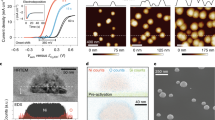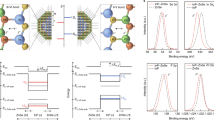Abstract
Interfaces between nanoscale and bulk electroactive materials are important for the design of electronic devices using solution-processed nanoparticles. We report that thin films of hexanethiolate-capped gold nanoparticles with a core diameter of 2.1±0.4 nm deposited onto n-InP wafers form Schottky contacts whose barrier height can be actively tuned from 0.27±0.03 to 1.11±0.09 eV by electrochemically adjusting the nanoparticle Fermi level. This result is remarkable because interfacial barriers at conventional metal–semiconductor contacts are largely insensitive to the initial Fermi level of the metal. Furthermore, it highlights two general features of solution-processed nanoparticle assemblies in comparison with traditional bulk electronic materials: (1) the ability of ions to permeate the nanoparticle assembly enables the electrochemical injection of charges and hence active control of the Fermi level, and (2) ligand passivation of nanoparticle surfaces prevents interfacial reactions with the semiconductor that could otherwise lead to strong Fermi-level pinning.
This is a preview of subscription content, access via your institution
Access options
Subscribe to this journal
Receive 12 print issues and online access
$259.00 per year
only $21.58 per issue
Buy this article
- Purchase on Springer Link
- Instant access to full article PDF
Prices may be subject to local taxes which are calculated during checkout





Similar content being viewed by others
References
Talapin, D. V. & Murray, C. B. PbSe nanocrystal solids for n- and p-channel thin film field-effect transistors. Science 310, 86–89 (2005).
Konstantatos, G. et al. Ultrasensitive solution-cast quantum dot photodetectors. Nature 442, 180–183 (2006).
Gur, I., Fromer, N. A., Geier, M. L. & Alivisatos, A. P. Air-stable all-inorganic nanocrystal solar cells processed from solution. Science 310, 462–465 (2005).
van Staveren, M. P. J., Brom, H. B. & de Jongh, L. J. Metal-cluster compounds and universal features of the hopping conductivity of solids. Phys. Rep. 208, 1–96 (1991).
Yu, D., Wang, C. J., Wehrenberg, B. L. & Guyot-Sionnest, P. Variable range hopping conduction in semiconductor nanocrystal solids. Phys. Rev. Lett. 92, 216802 (2004).
Banin, U. & Millo, O. Tunneling and optical spectroscopy of semiconductor nanocrystals. Annu. Rev. Phys. Chem. 54, 465–492 (2003).
Klein, D. L., McEuen, P. L., Katari, J. E. B., Roth, R. & Alivisatos, A. P. An approach to electrical studies of single nanocrystals. Appl. Phys. Lett. 68, 2574–2576 (1996).
Walzer, K., Marx, E., Greenham, N. C. & Stokbro, K. Scanning tunneling spectroscopy of CdSe nanocrystals covalently bound to GaAs. Surf. Sci. 532, 795–800 (2003).
Lee, T. et al. Electronic properties of metallic nanoclusters on semiconductor surfaces: Implications for nanoelectronic device applications. J. Nanopart. Res. 2, 345–362 (2000).
Sze, S. M. Physics of Semiconductor Devices (Wiley, New York, 1981).
Rhoderick, E. H. & Williams, R. H. Metal–Semiconductor Contacts (Oxford Univ. Press, Oxford, 1988).
Lonergan, M. C. A tunable diode based on an inorganic semiconductor|conjugated polymer interface. Science 278, 2103–2106 (1997).
Sailor, M. J., Klavetter, F. L., Grubbs, R. H. & Lewis, N. S. Electronic properties of junctions between silicon and organic conducting polymers. Nature 346, 155–157 (1990).
Daniels-Hafer, C., Jang, M., Boettcher, S. W., Danner, R. G. & Lonergan, M. C. Tuning charge transport at the interface between indium phosphide and a polypyrrole–phosphomolybdate hybrid through manipulation of electrochemical potential. J. Phys. Chem. B 106, 1622–1636 (2002).
Nozik, A. J. & Memming, R. Physical chemistry of semiconductor–liquid interfaces. J. Phys. Chem. 100, 13061–13078 (1996).
Pomykal, K. E. & Lewis, N. S. Measurement of interfacial charge-transfer rate constants at n-type InP/CH3OH junctions. J. Phys. Chem. B 101, 2476–2484 (1997).
Fajardo, A. M. & Lewis, N. S. Free-energy dependence of electron-transfer rate constants at Si/liquid interfaces. J. Phys. Chem. B 101, 11136–11151 (1997).
Yu, D., Wang, C. J. & Guyot-Sionnest, P. n-Type conducting CdSe nanocrystal solids. Science 300, 1277–1280 (2003).
Wehrenberg, B. L. & Guyot-Sionnest, P. Electron and hole injection in PbSe quantum dot films. J. Am. Chem. Soc. 125, 7806–7807 (2003).
Hicks, J. F., Miles, D. T. & Murray, R. W. Quantized double-layer charging of highly monodisperse metal nanoparticles. J. Am. Chem. Soc. 124, 13322–13328 (2002).
Chen, S. W. & Murray, R. W. Electrochemical quantized capacitance charging of surface ensembles of gold nanoparticles. J. Phys. Chem. B 103, 9996–10000 (1999).
Reiss, H. The Fermi level and the redox potential. J. Phys. Chem. 89, 3783–3791 (1985).
Wuelfing, W. P., Green, S. J., Pietron, J. J., Cliffel, D. E. & Murray, R. W. Electronic conductivity of solid-state, mixed-valent, monolayer-protected Au clusters. J. Am. Chem. Soc. 122, 11465–11472 (2000).
Pietron, J. J., Hicks, J. F. & Murray, R. W. Using electrons stored on quantized capacitors in electron transfer reactions. J. Am. Chem. Soc. 121, 5565–5570 (1999).
Brennan, J. L. et al. Electron hopping dynamics in monolayer-protected Au cluster network polymer films by rotated disk electrode voltammetry. Anal. Chem. 76, 5611–5619 (2004).
Tung, R. T. Electron transport at metal–semiconductor interfaces—general theory. Phys. Rev. B 45, 13509–13523 (1992).
Yu, A. Y. C. & Snow, E. H. Surface effects on metal–silicon contacts. J. Appl. Phys. 39, 3008–3016 (1968).
Newman, N., Kendelewicz, T., Bowman, L. & Spicer, W. E. Electrical study of Schottky-barrier heights on atomically clean and air-exposed n-InP (110) surfaces. Appl. Phys. Lett. 46, 1176–1178 (1985).
Gu, Y., Lin, Z., Butera, R. A., Smentkowski, V. S. & Waldeck, D. H. Preparation of self-assembled monolayers on InP. Langmuir 11, 1849–1851 (1995).
Lunt, S. R., Santangelo, P. G. & Lewis, N. S. Passivation of GaAs surface recombination with organic thiols. J. Vac. Sci. Technol. B 9, 2333–2336 (1991).
Sailor, M. J. et al. Thin fims of n-Si/poly-(CH3)3Si-cyclooctatetraene-conducting-polymer solar cells and layered structures. Science 249, 1146–1149 (1990).
Schaaff, T. G., Shafigullin, M. N., Khoury, J. T., Vezmar, I. & Whetten, R. L. Properties of a ubiquitous 29 kDa Au:SR cluster compound. J. Phys. Chem. B 105, 8785–8796 (2001).
Wessels, J. M. et al. Optical and electrical properties of three-dimensional interlinked gold nanoparticle assemblies. J. Am. Chem. Soc. 126, 3349–3356 (2004).
Bard, A. J. & Faulkner, L. R. Electrochemical Methods (Wiley, New York, 2001).
Reiss, H. & Heller, A. The absolute potential of the standard hydrogen electrode—a new estimate. J. Phys. Chem. 89, 4207–4213 (1985).
Acknowledgements
We thank E. McFarland, H. Nienhaus, N. Zheng and A. Ivanovskaya for insightful discussion. This work was supported by the NSF under awards DMR-02-33728 and ECCS-0609485, the Air Force Research Laboratory under agreement FA8650-05-1-5041 and the US Army Research Office via the Institute for Collaborative Biotechnologies through grant DAAD19-03D-0004, and made use of the MRL central facilities supported by the MRSEC Program of the NSF under award DMR-05-20415. S.W.B. thanks the NSF for a Graduate Research Fellowship.
Author information
Authors and Affiliations
Corresponding author
Ethics declarations
Competing interests
The authors declare no competing financial interests.
Supplementary information
Supplementary Information
Supplementary information and figures S1-S3 (PDF 867 kb)
Rights and permissions
About this article
Cite this article
Boettcher, S., Strandwitz, N., Schierhorn, M. et al. Tunable electronic interfaces between bulk semiconductors and ligand-stabilized nanoparticle assemblies. Nature Mater 6, 592–596 (2007). https://doi.org/10.1038/nmat1943
Received:
Accepted:
Published:
Issue Date:
DOI: https://doi.org/10.1038/nmat1943
This article is cited by
-
Electrical tuning effect for Schottky barrier and hot-electron harvest in a plasmonic Au/TiO2 nanostructure
Scientific Reports (2021)
-
All-thiol-stabilized Ag44 and Au12Ag32 nanoparticles with single-crystal structures
Nature Communications (2013)
-
Current voltage analysis and band diagram of Ti/TiO2 nanotubes Schottky junction
Applied Physics A (2012)
-
Interfaces behaving well
Nature Materials (2007)



